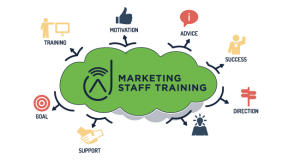Building your marketing bench strength should be an ongoing program in any organization. As we begin to think of the improvements we want to make in our lives and our businesses, the development of your team must somewhere near the top. I am not telling you it has to be the absolute top, but it should be a top consideration. I have worked in companies where developing bench strength was encouraged. I have worked in others where it was good if it happened and not so bad if it were ignored. I prefer the former.
 The truth is that some turnover is inevitable. Whether it is a natural progression for someone, job dissatisfaction, or personal reasons, you can count on 25% of managers to change or leave jobs. If your bench strength is too light, you will find yourself in a jam. That is a guaranteed outcome. It makes sense that building bench strength is a necessary part of any department plan. Managers may be surprised to discover creating a solid foundation for your team is not an HR-specific part of management. Managers need to fill a role as mentors and trainers on an ongoing basis. But where do you start if it is not by going to HR?
The truth is that some turnover is inevitable. Whether it is a natural progression for someone, job dissatisfaction, or personal reasons, you can count on 25% of managers to change or leave jobs. If your bench strength is too light, you will find yourself in a jam. That is a guaranteed outcome. It makes sense that building bench strength is a necessary part of any department plan. Managers may be surprised to discover creating a solid foundation for your team is not an HR-specific part of management. Managers need to fill a role as mentors and trainers on an ongoing basis. But where do you start if it is not by going to HR?
Step 1: Identify Business Needs
 Needs can generally be grouped into three areas: industry, job, and task. Industry-related needs are typically found when a new player comes into the market or when a company decides to expand into a new vertical. I started my marketing career at the time the casino industry was expanding into the regional markets. Although many people traveled to Las Vegas and Atlantic City in those early days, most of the workforce in the newer, regional markets had never stepped foot into a casino. The language was different. You almost needed a translator to work at or with a casino. The commonly used casino terms were a new language to everyone. Most of the initial team members needed complete industry training.
Needs can generally be grouped into three areas: industry, job, and task. Industry-related needs are typically found when a new player comes into the market or when a company decides to expand into a new vertical. I started my marketing career at the time the casino industry was expanding into the regional markets. Although many people traveled to Las Vegas and Atlantic City in those early days, most of the workforce in the newer, regional markets had never stepped foot into a casino. The language was different. You almost needed a translator to work at or with a casino. The commonly used casino terms were a new language to everyone. Most of the initial team members needed complete industry training.
As casinos continued to expand into markets, many operators found they were hiring well-meaning team members with no background in the jobs they were now responsible for. As a manager, you want the final output of the job itself to be of acceptable quality. If you find yourself constantly reviewing or perhaps changing someone’s work, they may need job-related skills training.
Here is where it gets a little tricky.
Sometimes you can assume a person needs job-related training, but they may need task-related training. What’s the difference? An excellent way to understand the difference in the need is to ask yourself whether the missing skill is inherently part of the position or something that comes with on-the-job training. For instance, a cashier at Target may have the skills to be a cashier at Walmart, but tasks may differ. We see this happen in cages across the country. Experienced cashiers apply and are hired, but the processes necessary in a casino are vastly different than those used by a retail cashier.
On-the-job training will typically satisfy task-related needs. If you think about your day at work, it is composed of many tasks. One happens after the other, and at the end of the day, you can feel like you have “done your job.”
When one or more of these tasks is a struggle, it can alter the outcome of your day. Productivity and morale suffer. So, a look at all the steps it takes to accomplish the work can assist in identifying task-related training needs.
Step 2: Perform a Gap Analysis
Go back to the team member’s job description. Compare the job or task descriptions where a gap might exist to the current outcomes.
Are there core job requirements that would improve with training?
Does the team member need to complete the tasks differently? Better? Faster? Using different tools? Coordinating more with others? Working more independently?
Specificity is key.
Is the task even part of this team member’s job?
What training have they already received? If they have not received training, why not? Often, management simply assumes the ability to accomplish certain types of tasks. Even with the right background, some experience differs from your organization’s expectations. As similar as jobs within the industry with the same job title can be, they can also be very different.
This step is probably the least time-consuming, if not the easiest of the three stages. The process is simple, and if you have been diligent in performance reviews, you should have easy access to documentation of the gaps you want to close. Comparing the initial job description to current behaviors and success should give you a clear picture of any gaps in team member training.
To be sure you have uncovered hidden needs, add one question to every performance evaluation. “If you could get training on any aspect of your job, what additional training would you like?” Your team members know best about their training gaps, as they face the necessity to complete the tasks every day.
Step 3: Assess Training Options
Once you have completed the gap analysis, determine if more than one training program is best for each team member. Many organizations find that several team members need the same training. Others find that individual team members require more unique programs. Check for group and individual options on the topics most suited for your people.
Plus, remember that even online, group training does have the potential to build morale and teamwork. This process is especially beneficial to integrate new team members and reconnect groups who have not seen each other for some time (or even those who see each other every day but have yet to form a true team).
Traditionally, training has been done in a classroom setting, but we have learned the options for training are almost as vast as the way team members successfully absorb the information. Will you travel for training, or does it have to come to you? Will it be instructor-led or self-paced? If you choose instructor-led, do you prefer in-person or recorded? Webinar or an anytime, anywhere option? Do you opt for a lab or hands-on environment, or do you record the processes as an example?
Lately, more and more training is available online. Team members have become more accustomed to Zoom calls and video conferences. Also, online training has become more measurable, accessible, and affordable.
Once you have gone through these assessments, you can start developing a training program, setting both short and long-term goals for the team member and the company, along with identifying potential resources.




Recent Comments